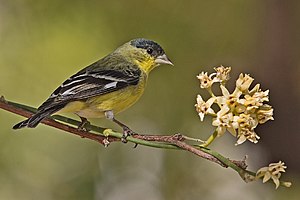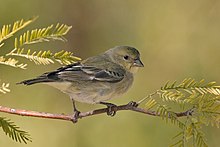Mexican siskin
| Mexican siskin | ||||||||||||
|---|---|---|---|---|---|---|---|---|---|---|---|---|

Mexican siskin ( Spinus psaltria ) |
||||||||||||
| Systematics | ||||||||||||
|
||||||||||||
| Scientific name | ||||||||||||
| Spinus psaltria | ||||||||||||
| ( Say , 1823) |
The Lesser Goldfinch ( Spinus psaltria , Syn. : Carduelis psaltria, Astragalinus psaltria ), also Mexikanerzeisig or Mexican Siskin called, is a species of the subfamily of the Stieglitz-like . It occurs in several subspecies. Its distribution area extends from North to South America.
Appearance
The Mexican siskin reaches a body length of eleven to twelve centimeters. There is a sexual dimorphism and the plumage color varies depending on the subspecies. In the nominate form , the top of the head, the sides of the face and the entire top of the body are black. In some subspecies, the black areas are limited to the forehead and skull. The neck, back, rump , wing covers , wings and tail are more olive green in these subspecies. In all subspecies, the underside of the male's body is bright yellow. The beak is horn-colored, the eyes are dark brown, and the feet are flesh-colored.
The female is generally less conspicuous in color. The underside of the body is dull and paler, the upper side is dull olive-brown.
Distribution area and habitat
The distribution area of the Mexican siskin stretches from the northwest of the United States , where it occurs in the extreme southwest of the US state of Washington , to Venezuela and Peru . In the colder regions of its range, it is a migratory bird. Its altitude distribution extends up to 2,500 meters in the mountains.
The Mexican siskin is a very adaptable species that occurs in a wide variety of habitats. It inhabits semi-open terrain, cultivated land interspersed with trees and bushes, occurs on the edges of forests, roads and on the banks of rivers and is also frequently observed in parks and gardens. On the other hand, it is absent in dense forests. Small flocks of up to six birds can often be found at feeding stations.
Way of life
The diet of the Mexican siskin consists primarily of various seeds of wild herbs. It also eats insects when the young are rearing. Eating earth has also been observed in this species.
The breeding season varies depending on the geographical distribution. In the temperate climates it only breeds in summer. In the climatically more favorable zones, clutches are observed all year round. The nest is cup-shaped and is made of grass, root fibers, moss, hair and feathers. It is located in bushes or at medium height in trees. The clutch consists of four to five eggs. The breeding period is thirteen days, the young birds fledge after 19 to 21 days. They are mostly fed by the male parent bird for another two weeks.
supporting documents
Individual evidence
literature
- Horst Bielfeld : siskins, giraffe, bullfinches and grosbeak. Verlag Eugen Ulmer, Stuttgart 2003, ISBN 3-8001-3675-9 .
- Cisneros-Heredia, Diego F. (2006): Notes on breeding, behavior and distribution of some birds in Ecuador. , Bulletin of the British Ornithologists' Club 126 (2): 153-164. PDF
- Delgado-V., Carlos A. (2006): Observación de geofagia por el Jiguero Aliblanco Carduelis psaltria (Fringillidae). ["Report of geophagy in the Lesser Goldfinch C. psaltria (Fringillidae)"]. Boletín de la Sociedad Antioqueña de Ornitología 16 (2): 31-34. [Spanish with summary in English] PDF
Web links
- Spinus psaltria inthe IUCN Red List of Threatened Species 2017.3. Listed by: BirdLife International, 2016. Retrieved January 25, 2018.
